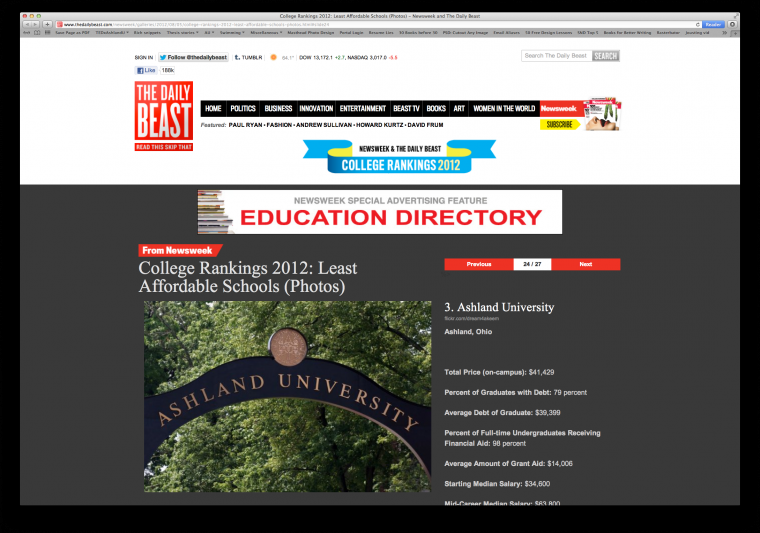Least affordable ranking not entirely accurate
August 22, 2012
On August 6, Newsweek magazine and news and opinion website The Daily Beast released a list of 25 colleges that they considered least affordable.
Ashland University ranked third.
The list displayed data including total price of living on campus, percent of graduates with debt, average debt, percentage of undergraduate students receiving financial aid and several other factors.
While many students laughed at the ranking, casually remarking about how proud they are of their expensive school, Ashland University administration has been very concerned as to why their school ranked so high on the list.
Vice President for Enrollment Management and Marketing Dr. Scott Van Loo investigated the methodology and data used by Newsweek to give out the ranking and found that the results were misleading.
“One of the things you have to look at whenever you end up on a list, either good or bad, is look at the methodology,” Van Loo said. “[Newsweek] looked at a variety of factors when creating this list. One of the ones I think you can poke holes in is that 25% of their ranking was based on median income for recent grads as well as grads 30 years into their careers and average earning potential data from Payscale.com.
“I’ve heard from other institutions that were frustrated with Payscale because they felt they were somehow gathering data and earning potential from graduates but no one has a handle on how many graduates they gathered data from.”
Ashland University boasts over forty thousand graduates and Van Loo wondered what sample of those graduates Payscale was using to gather data.
“It appears that they only include graduates with just Bachelor degrees,” Van Loo said.
Payscale.com’s methodology states that only graduates with Bachelor degrees were collected, thus ruling out anyone with any kind of graduate degree, master’s degree or doctorate and therefore eliminating law, medical, some educational professions and many other careers from the data.
“With that in mind it’s hard to see how truly representative of a sample of graduates this is,” Van Loo said.
Van Loo said that this is only one of a few factors that he believes has skewed the data against Ashland University.
Another factor that played into Ashland’s high ranking was the percentage of students getting financial aid from the school: 98 percent.
“It appears [according to the ranking] that if you have a high number of students receiving financial aid then it’s a bad thing,” Van Loo said. “In this survey, giving students financial aid is a negative.”
Van Loo recommended that to find the best information regarding the schools with the highest net prices or schools with the highest tuition, visit the College Center for Affordability and Transparency website. The site (collegecost.ed.gov), backed by the US Department of Education, shows schools ranked according to highest tuition and net price (tuition minus financial aid). Ashland University does not appear on either list of over 60 private not-for-profit schools.
“If we had showed up on this list it would have been something we looked at a long time ago,” Van Loo said.
Van Loo also said in a press statement regarding the Newsweek ranking that the data collected goes as far back as 2009 and significant changes have occurred at Ashland University over the past 2 years including a three-year degree program, allowing students to get a degree faster and for less money; a four-year graduation guarantee program to keep college costs predictable; approving a more than 17 percent increase in merit based scholarships for the upcoming year; approving a total of 1.1 percent increase in tuition and room and board fees; launching an accelerated accounting degree program that allows students to complete programs faster; and finally by reducing the number of credit hours needed to earn a bachelor’s degree from 128 to 120.
Van Loo added that when comparing Ashland’s 1.1 percent tuition increase to the national average of tuition increase across private 4-year colleges, 9 percent, Ashland University is working harder to make tuition and costs more affordable.
“We know that we need to keep an eye on [tuition],” Van Loo said. “If you look at the efforts we are taking to really address cost, you would be hard pressed to find a lot of institutions that took that aggressive of steps towards lowering costs.”
Regardless of Newsweek’s ranking, Van Loo and the rest of Ashland’s administration are working to make costs more affordable at AU.
“Unfortunately, that ranking is out there,” Van Loo said. “But now we have to make people understand why our costs are what they are. We think there are some flaws in [Newsweek’s] methodology but without all the facts, we are just left to respond to what was published.”
During her Feb. 29 visit to Ashland University, Martha Kanter, Under Secretary of Education, praised AU for the steps it has taken to make college more affordable.
“Ashland is a think tank,” Kanter said in February. “…AU is measuring up…You can look at any number of things that have happened here at this university and say, ‘This is an island of excellence.’ I want a country of excellence. That’s what we need.”


